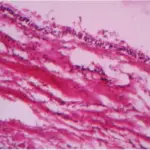A calcifying epithelial odontogenic cyst (Gorlin Cyst) is a benign odontogenic cyst that occurs in the gnathic bones. This cyst is part of a spectrum of lesions characterized by odontogenic epithelium containing “ghost cells,” which may undergo calcification.
What is the Pathology of Calcifying Epithelial Odontogenic Cyst (Gorlin Cyst)?
The pathology of Calcifying epithelial odontogenic cyst (Gorlin Cyst):
-Etiology: The cause of calcifying epithelial odontogenic cyst (Gorlin Cyst) is odontogenic epithelial remnants (remains) that were trapped within the bones of the maxilla and mandible or gingival tissues. It is associated with impacted and unerupted teeth.
-Genes involved: The human homolog of the Drosophila segment polarity gene PTCH1.
-Pathogenesis: The sequence of events that lead to calcifying epithelial odontogenic cyst (Gorlin Cyst) Epithelial lining has the ability to induce the formation of dental tissues in adjacent connective tissue walls.
-Histology: The histology associated with calcifying epithelial odontogenic cyst (Gorlin Cyst) shows the stratified squamous epithelium.
How does Calcifying Epithelial Odontogenic Cyst (Gorlin Cyst) Present?
Patients with calcifying epithelial odontogenic cyst (Gorlin Cyst) typically affects male and female both present at the range of 33 and above. The symptoms, features, and clinical findings are associated with calcifying epithelial odontogenic cysts (Gorlin Cyst); Most calcifying odontogenic cysts appear asymptomatic. They are normally presented as a painless, slow-growing mass on the mandible and/or the maxilla, mostly in the front of the mouth. Symptoms include swelling in the mouth, both inside the bone, in the tooth-bearing areas, and outside the bone, in the gingiva.
How is Calcifying Epithelial Odontogenic Cyst (Gorlin Cyst) Diagnosed?
A calcifying epithelial odontogenic cyst (Gorlin Cyst) is diagnosed through a radiograph and CT scan.
How is Calcifying Epithelial Odontogenic Cyst (Gorlin Cyst) Treated?
A calcifying epithelial odontogenic cyst is treated as enucleation and curettage.
What is the Prognosis of Calcifying Epithelial Odontogenic Cyst (Gorlin Cyst)?
The prognosis of the calcifying epithelial odontogenic cyst (Gorlin Cyst) is favorable. It has minimal chance of recurrence after simple surgical removal.



